Weathering Characteristics of Wood Plastic Composites Reinforced with Extracted or Delignified Wood Flour
Abstract
:1. Introduction
2. Materials and Methods
2.1. Materials
2.2. Wood Flour Extractions
2.3. HDPE Composites Manufacturing
2.4. HDPE Composites Weathering
2.5. Color Measurement
2.6. Fourier Transform Infrared Spectroscopy
2.7. Mechanical Property Testing
2.8. Scanning Electron Microscopy
2.9. Statistical Analysis
3. Results and Discussion
3.1. Fourier Transform Infrared Spectroscopy
3.2. Color Parameter Changes
3.3. Flexural Properties of Modified Wood Based WPC
3.4. Surface Properties Analysis
3.5. Statistical Analysis
4. Conclusions
Acknowledgments
Author Contributions
Conflicts of Interest
References
- Chen, Y.; Tshabalala, M.A.; Gao, J.; Stark, N.M.; Fan, Y. Color and surface chemistry changes of extracted wood flour after heating at 120 °C. Wood Sci. Technol. 2014, 48, 137–150. [Google Scholar] [CrossRef]
- Chen, Y.; Tshabalala, M.A.; Gao, J.; Stark, N.M.; Fan, Y.; Ibach, R.E. Thermal behavior of extracted and delignified pine wood flour. Thermochim. Acta 2014, 591, 40–44. [Google Scholar] [CrossRef]
- Chen, Y.; Stark, N.M.; Tshabalala, M.A.; Gao, J.; Fan, Y. Properties of wood-plastic composites (WPCs) reinforced with extracted and delignified wood flour. Holzforschung 2014, 68, 933–940. [Google Scholar] [CrossRef]
- Stark, N.M.; Matuana, L.M.; Clemons, C.M. Effect of processing method on surface and weathering characteristics of wood-flour/HDPE composites. J. Appl. Polym. Sci. 2004, 93, 1021–1030. [Google Scholar] [CrossRef]
- Shahi, P.; Behravesh, A.H.; Daryabari, S.Y.; Lotfi, M. Experimental investigation on reprocessing of extruded wood flour/HDPE composites. Polym. Compos. 2012, 33, 753–763. [Google Scholar] [CrossRef]
- Muasher, M.; Sain, M. The efficacy of photostabilizers on the color change of wood filled plastic composites. Polym. Degrad. Stab. 2006, 91, 1156–1165. [Google Scholar] [CrossRef]
- Stark, N.M.; Matuana, L.M. Ultraviolet weathering of photostabilized wood flour-HDPE composites. J. Appl. Polym. Sci. 2003, 90, 2609–2617. [Google Scholar] [CrossRef]
- Ku, H.; Wang, H.; Pattarachaiyakoop, N.; Trada, M. A review on the tensile properties of natural fiber reinforced polymer composites. Compos. Part B 2011, 42, 856–873. [Google Scholar] [CrossRef] [Green Version]
- Stark, N.M. Effect of weathering cycle and manufacturing method on performance of wood flour-high-density polyethylene composites. J. Appl. Polym. Sci. 2006, 100, 3131–3140. [Google Scholar] [CrossRef]
- Bengtsson, M.; Stark, N.M.; Oksman, K. Durability and mechanical properties of silane cross-linked wood thermoplastic composite. Compos. Sci. Technol. 2007, 67, 2728–2738. [Google Scholar] [CrossRef]
- Wei, L.; McDonald, A.G. A review on grafting of biofibers for biocomposites. Materials 2016, 9, 303. [Google Scholar] [CrossRef]
- Jelle, B.P.; Nilsen, T.N. Comparison of accelerated climate ageing methods of polymer building materials by attenuated total reflectance Fourier Transform Infrared Radiation spectroscopy. Constr. Build. Mater. 2011, 25, 2122–2132. [Google Scholar] [CrossRef]
- Fabiyi, J.S.; McDonald, A.G. Physical morphology and quantitative characterization of chemical changes of weathered PVC/pine composites. J. Polym. Environ. 2010, 18, 57–64. [Google Scholar] [CrossRef]
- Wei, L.; McDonald, A.G. Accelerated weathering studies on the bioplastic, poly (3-hydroxybutyrate-co-3-hydroxyvalerate). Polym. Degrad. Stab. 2016, 126, 93–100. [Google Scholar] [CrossRef]
- Filson, P.; Dawson-Andoh, B.E.; Matuana, L. Colorimetric and vibrational spectroscopic characterization of weathered surfaces of wood and rigid polyvinyl chloride–wood flour composite lumber. Wood Sci. Technol. 2009, 43, 669–678. [Google Scholar] [CrossRef]
- Ndiaye, D.; Fanton, E.; Morlat-Therias, S.; Vidal, L.; Tidjani, A.; Gardette, J.L. Durability of wood polymer composites: Part 1. Influence of wood on the photochemical properties. Compos. Sci. Technol. 2008, 68, 2779–2784. [Google Scholar] [CrossRef]
- Kiguchi, M.; Kataoka, Y.; Matsunaga, H.; Koichi, Y.; Evans, P.D. Surface deterioration of wood-flour polypropylene composites by weathering trials. J. Wood Sci. 2007, 53, 234–238. [Google Scholar] [CrossRef]
- Rangaraj, S.V.; Smith, L.V. Effects of moisture on the durability of a wood/thermoplastic composite. J. Thermoplast. Compos. Mater. 2000, 13, 140–161. [Google Scholar] [CrossRef]
- Wei, L.; McDonald, A.G.; Freitag, C.; Morrell, J.J. Effects of wood fiber esterification on properties, weatherability and biodurability of wood plastic composites. Polym. Degrad. Stab. 2013, 98, 1348–1361. [Google Scholar] [CrossRef]
- Stark, N.M.; Matuana, L.M. Characterization of weathered wood-plastic composite surfaces using FTIR spectroscopy, contact angle, and XPS. Polym. Degrad. Stab. 2007, 92, 1883–1890. [Google Scholar] [CrossRef]
- Stark, N.M.; Mueller, S.A. Improving the color stability of wood-plastic composites through fiber pre-treatment. Wood Fiber Sci. 2008, 40, 271–278. [Google Scholar]
- Hon, D.N.S.; Shiraishi, N. Wood and Cellulose Chemistry, 2nd ed.; Marcel Dekker: New York, NY, USA, 2001; p. 914. [Google Scholar]
- Kalnins, M.A.; Feist, W.C. Increase in the wettability of wood with weathering. For. Prod. J. 1999, 43, 55–57. [Google Scholar]
- Fabiyi, J.S.; McDonald, A.G.; McIlroy, D. Wood modification effects on weathering of HDPE-based wood plastic composites. J. Polym. Environ. 2009, 17, 34–48. [Google Scholar] [CrossRef]
- Saputra, H.; Simonsen, J. Effect of extractives on the flexural properties of wood/plastic composites. Compos. Interfaces 2004, 11, 515–524. [Google Scholar] [CrossRef]
- ASTM. ASTM D1238-Standard test methods for melt flow rates of thermoplastics by extrusion plastometer. In Annual Book of ASTM Standards; American Society for Testing and Materials: Conshohocken, PA, USA, 2013. [Google Scholar]
- Wise, L.E.; Murphy, M.; D’Addireco, A.A. Chlorite holocellulose, its fraction bearing on summative wood analysis and on the hemicelluloses. Paper Trade J. 1946, 122, 35–43. [Google Scholar]
- ASTM. ASTM 790-Standard test methods for flexural properties of unreinforced and reinforced plastics and electrical insulating materials. In Annual Book of ASTM Standards; American Society for Testing and Materials: Conshohocken, PA, USA, 2010. [Google Scholar]
- ASTM. ASTM D2565-Standard practice for xenon-arc exposure of plastics intended for outdoor applications. In Annual Book of ASTM Standards; American Society for Testing and Materials: Conshohocken, PA, USA, 2008. [Google Scholar]
- ASTM. ASTM D2244-Standard practices for calculation of color tolerances and color differences from instrumentally measured color coordinates. In Annual Book of ASTM Standards; American Society for Testing and Materials: Conshohocken, PA, USA, 2009. [Google Scholar]
- Zerbi, G.; Gallino, G.; Del Fanti, N.; Baini, L. Structural depth profiling in polyethylene films by multiple internal reflection infrared spectroscopy. Polymers 1989, 30, 2324–2327. [Google Scholar] [CrossRef]
- Kaci, M.; Sadoun, T.; Cimmino, S. Crystallinity measurements of unstabilized and HALS-stabilized LDPE films exposed to natural weathering by FT-IR, DSC and WAXS analyses. Int. J. Polym. Anal. Charact. 2001, 6, 455–464. [Google Scholar] [CrossRef]
- Pandey, K.K. Study of the effect of photo-irradiation on the surface chemistry of wood. Polym. Degrad. Stab. 2005, 90, 9–20. [Google Scholar] [CrossRef]
- Stark, N.M.; Matuana, L.M. Surface chemistry changes of weathered HDPE/wood-flour composites studied by XPS and FTIR spectroscopy. Polym. Degrad. Stab. 2004, 86, 1–9. [Google Scholar] [CrossRef]
- Thakur, V.K.; Thakur, M.K. Processing and characterization of natural cellulose fibers/thermoset polymer composites. Carbohyd. Polym. 2014, 109, 102–117. [Google Scholar] [CrossRef] [PubMed]
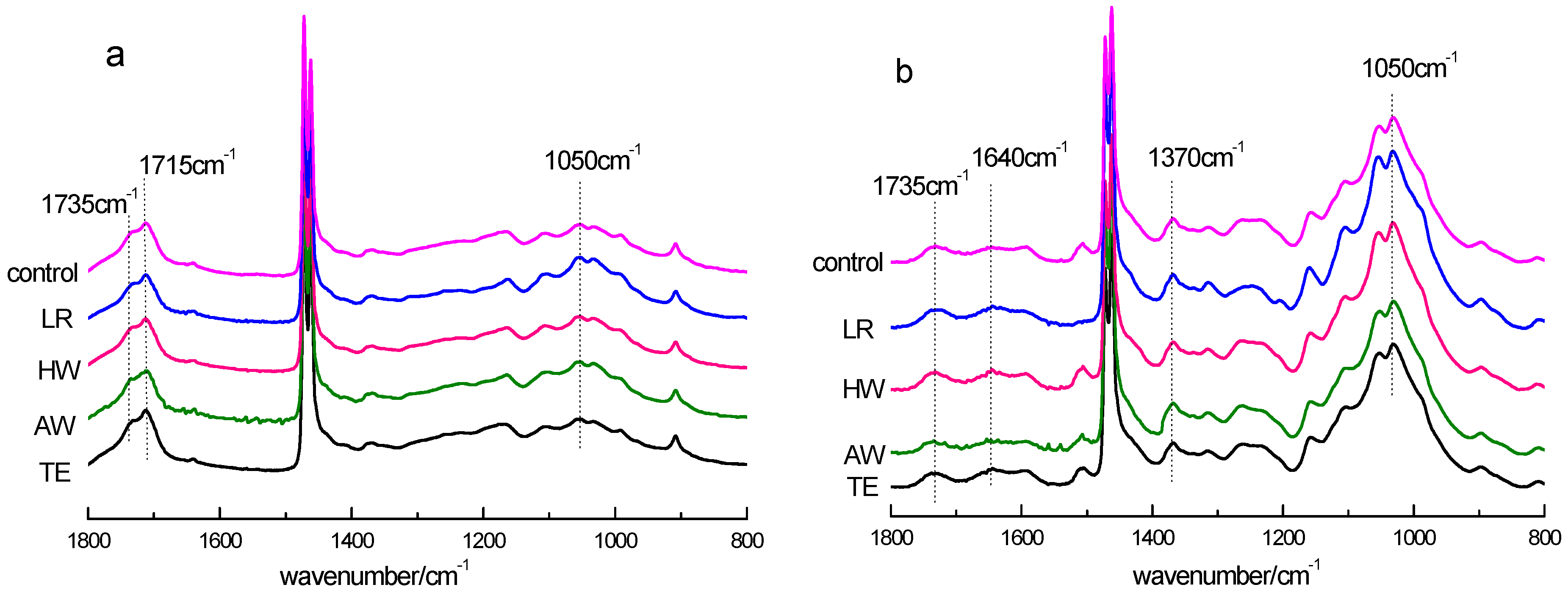
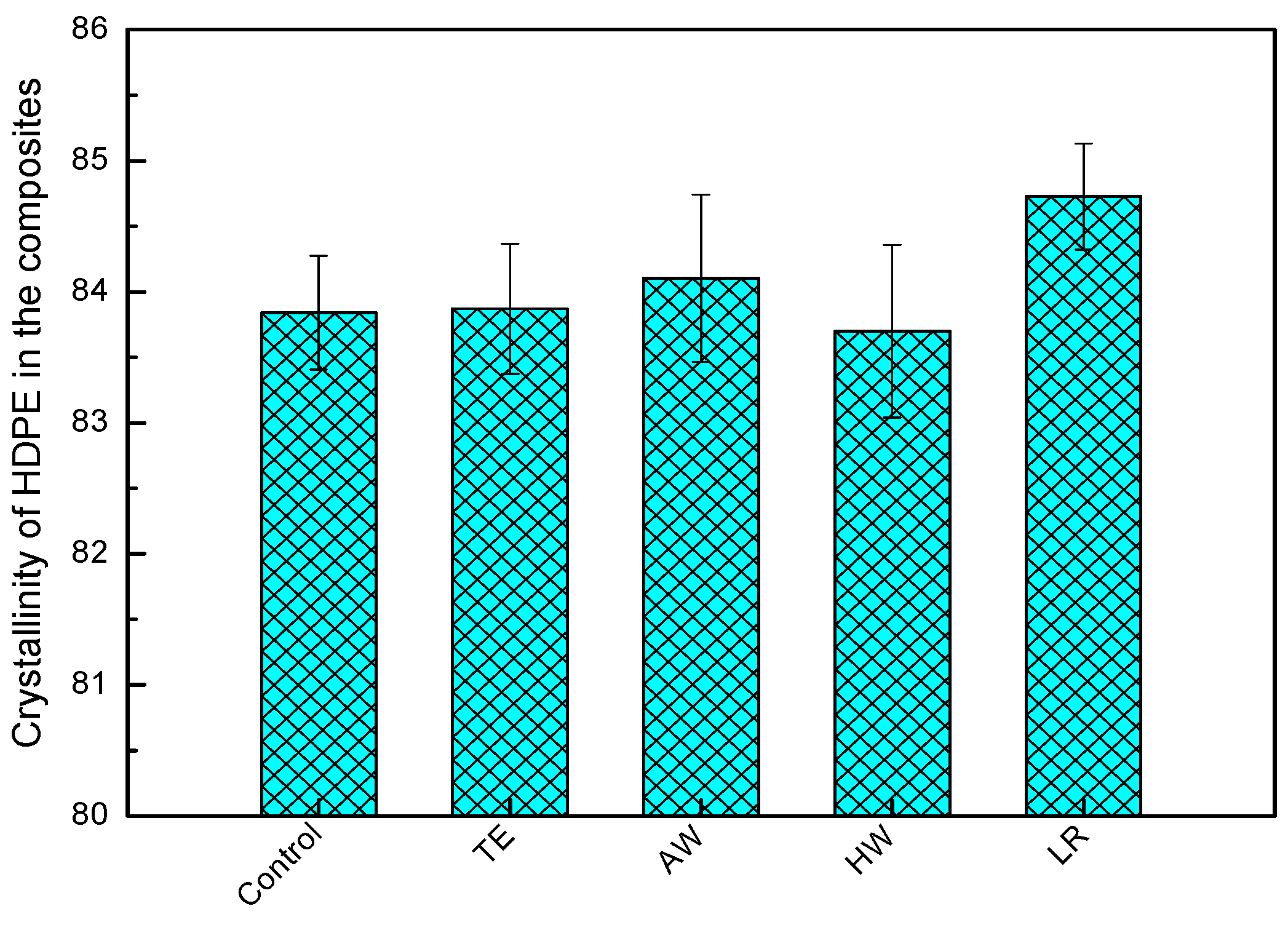
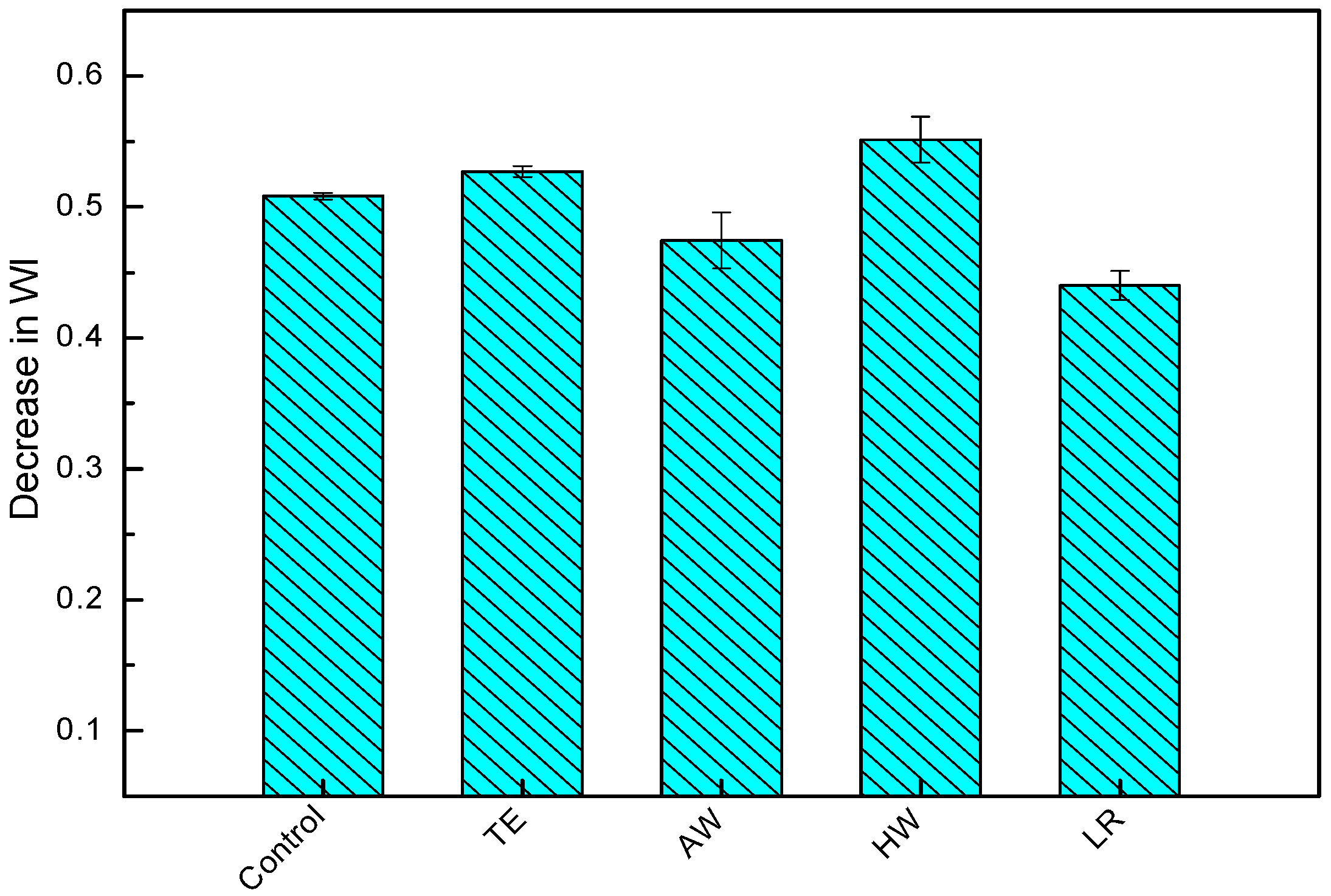
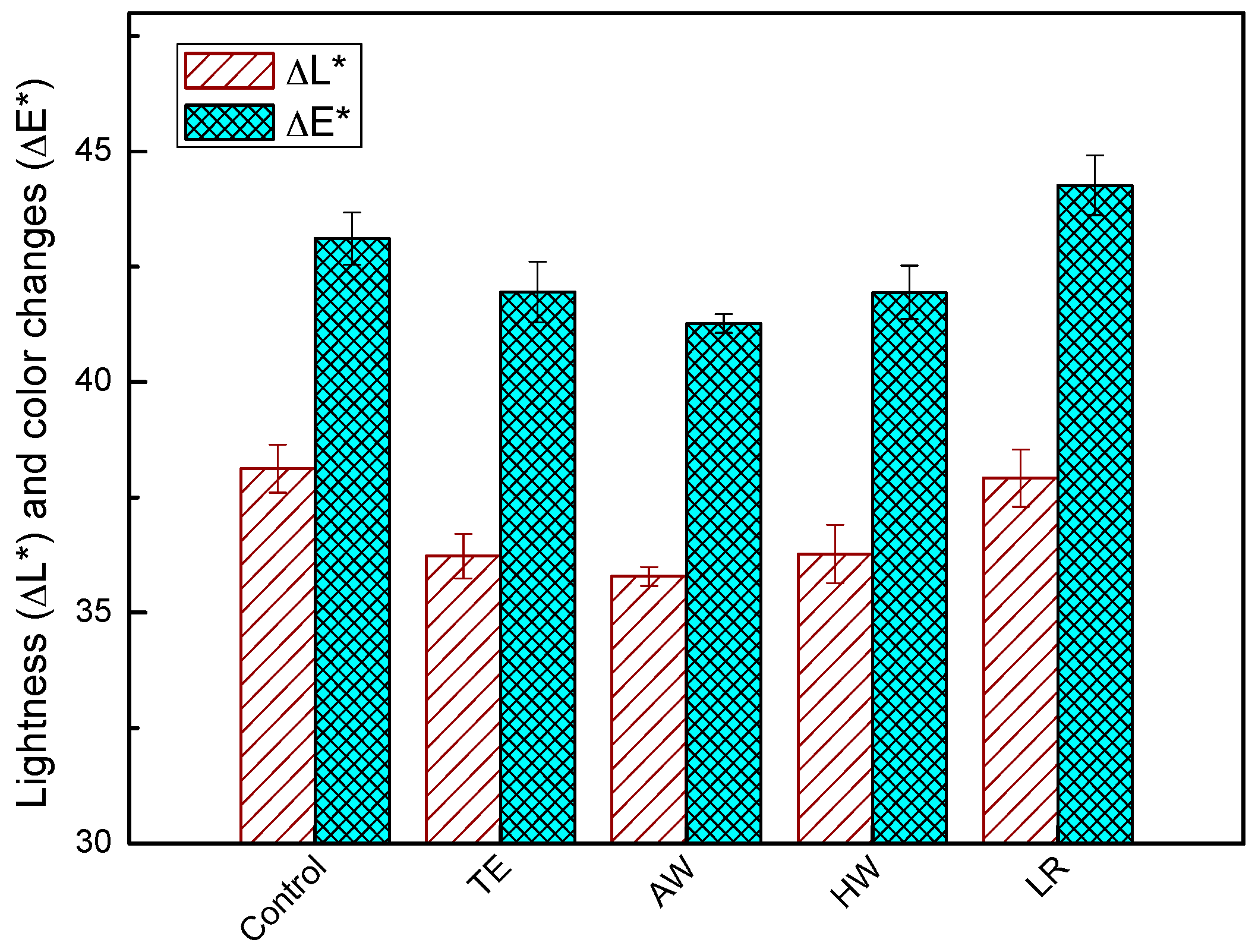
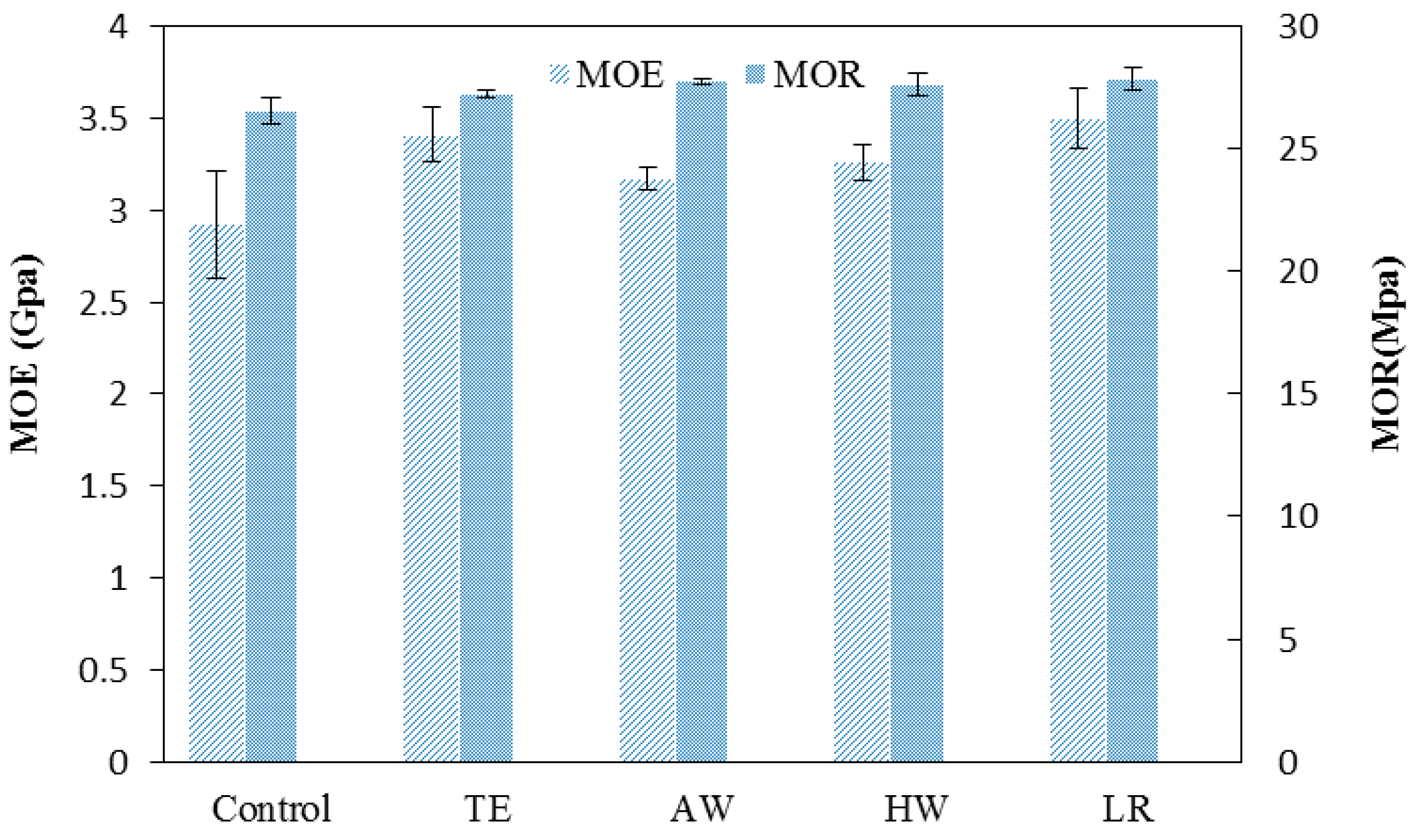

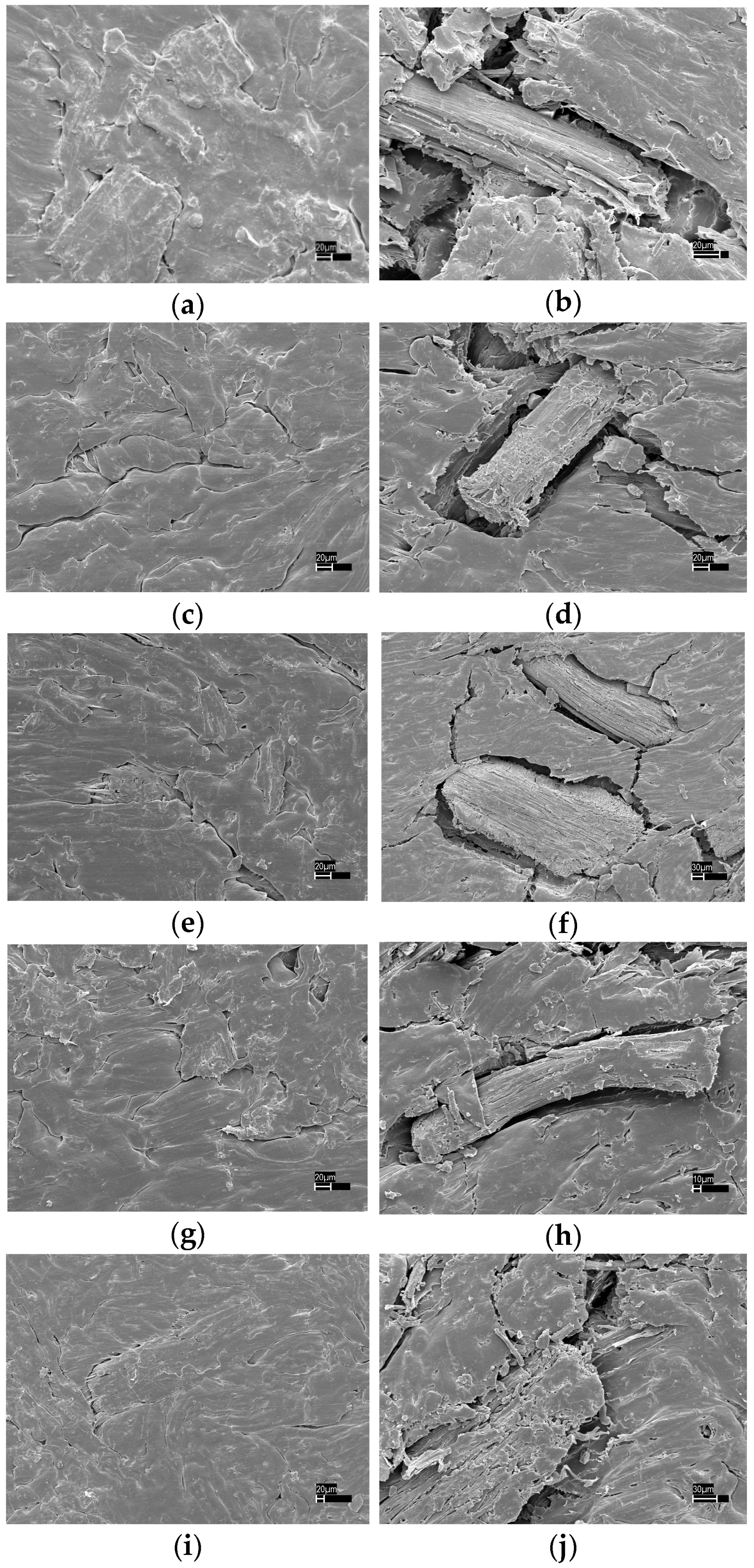
| Source | Sum of Squares | df | Mean Square | F Value | p-Value Prob > F | Significant |
|---|---|---|---|---|---|---|
| Model | 531.66 | 4 | 132.91 | 11.05 | 0.0008 | significant |
| TE | 7.07 | 1 | 7.07 | 0.58 | 0.4591 | – |
| AW | 31.02 | 1 | 31.02 | 2.57 | 0.1366 | – |
| HW | 2.98 | 1 | 2.98 | 0.24 | 0.6278 | – |
| LR | 490.59 | 1 | 490.59 | 40.81 | < 0.0001 | – |
| Residual | 132.21 | 11 | 12.01 | – | – | – |
| Corrected Total | 663.87 | 15 | – | – | – | – |
© 2016 by the authors; licensee MDPI, Basel, Switzerland. This article is an open access article distributed under the terms and conditions of the Creative Commons Attribution (CC-BY) license (http://creativecommons.org/licenses/by/4.0/).
Share and Cite
Chen, Y.; Stark, N.M.; Tshabalala, M.A.; Gao, J.; Fan, Y. Weathering Characteristics of Wood Plastic Composites Reinforced with Extracted or Delignified Wood Flour. Materials 2016, 9, 610. https://doi.org/10.3390/ma9080610
Chen Y, Stark NM, Tshabalala MA, Gao J, Fan Y. Weathering Characteristics of Wood Plastic Composites Reinforced with Extracted or Delignified Wood Flour. Materials. 2016; 9(8):610. https://doi.org/10.3390/ma9080610
Chicago/Turabian StyleChen, Yao, Nicole M. Stark, Mandla A. Tshabalala, Jianmin Gao, and Yongming Fan. 2016. "Weathering Characteristics of Wood Plastic Composites Reinforced with Extracted or Delignified Wood Flour" Materials 9, no. 8: 610. https://doi.org/10.3390/ma9080610





